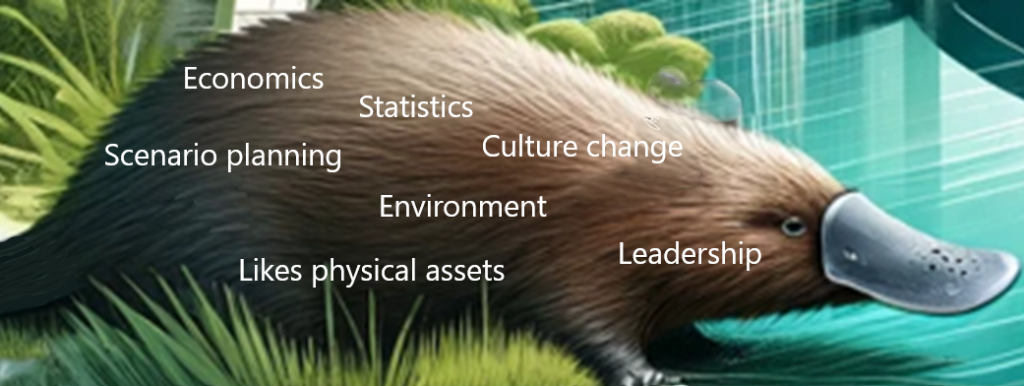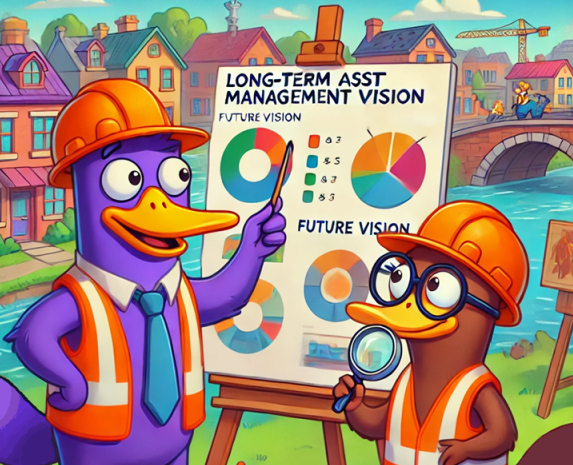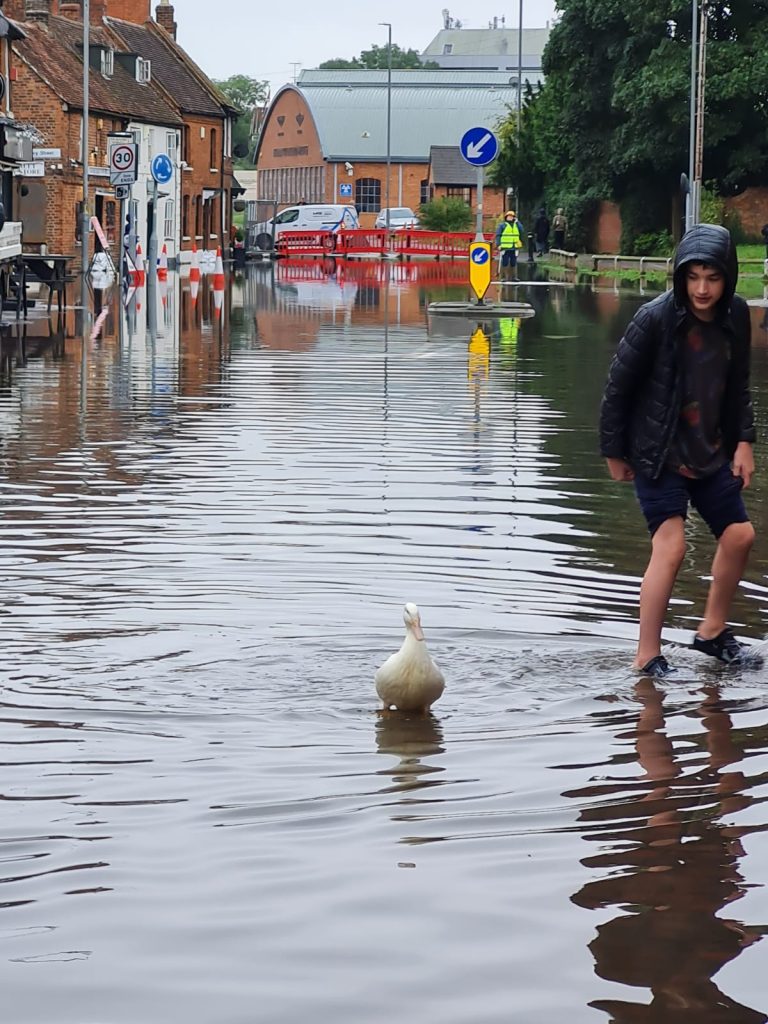
Image from James Webb Telescope: Interacting Galaxies
After taking three months off – impressed how much surgery slowed me down! – I am taking stock.
I find I am almost totally not interested in Asset Management as a technical subject. Or rather, that I have no hope that something technical (like ‘AI’) will sort it for us.
And yet, there is still a large problem to be sorted, that surely requires new, and clever, thinking.
The Talking Infrastructure board is more or less convinced that we have not yet made Asset Management stick. In particular, to get where Penny saw 40 years ago: business as usual longer term planning to meet infrastructure demand. And more recently, planning ahead in a changing world.
One painful example is the retreat from meaningful AMPs in Australian councils, their first home.
Why infrastructure organisations don’t face the future has been a puzzle. Vested interests, for example in the construction industry, sure; lack of skill or vision in the decision-makers, yeah. Is it basically that the pain of not planning adequately doesn’t fall on the people failing to plan?
Our inability as a species to think beyond a few years?
But I am not yet that pessimistic. I don’t believe it’s biological.
What most grips me is the problem of culture. Yes, we happen to live in a peculiarly short-termist culture. But let’s, as clever people, tackle it as a Meadows-type system challenge.
In the past decade some of us have asked how we can get an organisation to plan sustainably: to have a process, a system to plan out our assets, that outlives any CEO, or any individual asset manager for that matter. A few years ago, a network of us in North America looked at how to ensure that an incoming CEO took an AMP process as given. Useful and entrenched enough not to be their focus for change.
Did we succeed anywhere?
Watch this space…

Legacy: A Decision Maker’s Guide to Infrastructure is published!
It’s a slim, elegant book aimed at councillors and C-suites to convey the realities of infrastructure, and the vital support a good Asset Management can provide to them.
Available as ebook or print on demand through Amazon.
‘Legacy: A Decision-Maker’s Guide to Infrastructure is not another technical manual. It’s a clear-eyed, call to rethink how we lead and make decisions about the physical assets that shape our daily lives – from water systems and roads to hospitals, parks, and transit networks.
Written by respected infrastructure thinkers, Ruth Wallsgrove and Lou Cripps, Legacy distills decades of frontline experience into practical guidance for those who carry the weight of stewardship. This isn’t about technology or buzzwords. It’s about responsibility. Clarity. Purpose. And asking better questions.’
Design by the wonderful Matt Miles – much gratitude again

From script by Lou Cripps
As infrastructure organisations start to make use of large language models (LLM) – popularly labelled artificial intelligent, though they are not actually thinking – do we know where we want them to take us?
Talking Infrastructure members are involved in some experimentation here. Blue Mountains City Council, for example, is trialling such technology to automate rural road inspections from LLM interpretation of videos of defects.
Lou Cripps is training models with curated Asset Management information. That is, instead of letting something like ChatGPT loose on all sources, weighting scripts to focus on known and reliable material like SAM newsletter articles. (Otherwise, they are biased towards financial AM, since there’s much more of that material around.)
As Talking Infrastructure looks at how such tools can help make good AM practice more accessible, and what principles we need when, not if, organisations try using LLM in decision processes such as where to schedule road maintenance:
What have you used so far? Where do you think we can make best use of LLM?

If Asset Management is to deliver better asset planning, we have a challenge. Are we living up to it?
The most obvious thing about AM is that it’s about physical assets. And for most of its history, the assumption has been that the main quality of an asset manager is that they need a background in those areas most concerned with physical assets: that is, engineering, operations, or maintenance.
Who else knows or cares about physical assets? And without that interest, AM might be unmoored: a branch of finance or corporate planning that simply doesn’t know or care enough.
The dilemma is that we need other skills that don’t come for free with delivery backgrounds.
Worse, we need perspectives that definitely go against what we learn in engineering school, or the motivation of operations.
- How do we nurture a profession of people who really like the realities of physical assets but think in a new way about them?
- How early do we need to reach potential asset managers?
There are some good signs – Dr Monica Beedles’ Street Smarts and Biz Smarts, for example, and the Canadian Network of Asset Managers (CNAM) work on AM competences. (And shout out to pioneers of new ways of getting to undergraduates – hello, Valerie Marcolengo!)
But, as CNAM points out, we have a chronic shortage of asset managers.
And many who struggle in post without the tools of effective asset management planning.
How do we reach those with the environmental, analytical, process, culture change and bigger picture skills we need?
What is your ideal undergraduate syllabus to grow the next generation of asset managers?
Thanks to the British Columbia South Island AM Community of Practice for the opportunity to discuss competences this week!

From script by Lou Cripps
What’s the responsibility of Asset Management? In my mind, there’s no question.
The output from an effective Asset Management system is a better allocation of resources to physical assets. It’s all about allocating $ and people where they are most needed, and not to spend or do where that is not needed.
And that can mean only one thing. AM – the system, not the team – should be the major input to the budgeting process for asset-intensive sectors such as power. And a major input wherever there is a significant amount of budget at stake.
The Asset Management input to the budgeting process is what Penny originally called the AMP. Given that ISO 55000 didn’t quite get it, I wonder if we should now spell it out – the asset management planning process (AMPP). One integrated, co-ordinated process that looks across the whole asset base with consistent principles on which to base decisions about priorities for the medium and long term.
We should expect – hope, indeed! – that this will over time have a major impact on business budgeting. That asset-related budgets will change significantly when we have a more optimising system, to make better use of information and plan further into the future.
The focus is not individual decisions, but the wider decision processes.
- What are the priorities for asset renewals, that is major work to replace or refurbish assets?
- What is the appropriate level of planned maintenance to optimise cost, risk and performance?
- Given the current state of the asset base, what is a realistic level of allocation to reactive work going forward?
- How do any growth or new assets fit within the overall strategy (and how important are they in relation to sustaining the assets/ services we already have)?
And this is not planning just about the physical assets. Both the money and the resources have to be considered: there is little point in arguing for money if there is not also a realistic plan for the people to deliver the work.
If we agree this is what Asset Management has to deliver, that also tells us what the main job of a dedicated AM function is and its key relationships with other functions. We can work through what kind of skills and capabilities we require, and where AM sits in the organisation.
It’s why I don’t consider Asset Management in any sense a sub-branch of Engineering – or the capabilities what we teach on current engineering degrees. It’s also not Finance, or HR, or Procurement, though it involves all of these.
And the bigger the amount of dollars at stake, the more vital that we do good Asset Management.
Talking Infrastructure is looking again at the AMP and the asset planning we require for future-friendly infrastructure. If you would like to be involved, contact us!

From script by Lou Cripps
Sometimes, it feels too much to do it all step by step.
Most organisations I work with don’t yet have any asset plans beyond five years. Some still only have annual budgets. How do you add in changing requirements for the longer term if you don’t even ask past five years?
And how many years ago did asset managers realise you can’t plan if you don’t think about where you want to get to? (At least 20, because strategy comes before planning in BSI PAS-55 published in in 2004.) But almost no-one has properly strategic ‘asset strategies’. They literally don’t know where they want to take their assets.
Bit by bit – and maybe getting nowhere fast.
But there is an alternative, maybe. Can we describe a compelling vision of where we want to be, first?
Can we even leapfrog some of the gradualist things we currently do?
Gradualism may be personal preference, or professional training. We haven’t always been bold about our mission. Some of us are detail people.
How would it be if we really believed we have a duty of care to make a big difference to the, frankly, fairly dumb way we’ve conventionally managed infrastructure?
Todd Shepherd and Julie DeYoung describe this as a system thing. What we have is a system, or paradigm, which resists change – so tinkering at the edges doesn’t work, because the old system will just bounce back as soon as you stop pushing.
This is, of course, quite a different concept of ‘system’ from the parts and pieces idea of a ‘quality management’ approach such as ISO 55000, which instead encourages a bit by bit, start with AM policy or SAMP. Better than thinking the first step has to be IT – but possibly no more ‘sticky’.
Quicker, and less heartache, to go for undermining the whole thing with strategy and long-term planning from the start?

From script by Lou Cripps
Bad news for techies, but infrastructure is mostly money, business and politics.
Yes, Asset Management is about making better decisions on our physical assets. But not just any decisions: the wider, longer-term, strategy and co-ordination that organisations struggle with.
Operations already take care of immediate responses. Engineers are more than happy to focus on the technical details. Finance counts the money – but struggles to do more because it doesn’t get the honest information about the assets that it needs.
The gap that Penny Burns identified in 1984 was, first of all, planning for capital renewals to maintain the infrastructure base we already have, beyond the next year. A need most people didn’t even notice, let alone take on to fill.
In the forty years since, Penny has talked extensively about decisions for new infrastructure as well. About how the overall system needs to change to meet changing demands for service. And the impact of physical assets on the economy, the environment, our communities.
In other words, Strategic Asset Management.
In the past few years I have been asked to develop webinars and other support for better asset strategy and planning. My fundamental message is A. Strategy and planning are not the same, and B. they are complementary, and we need them both.
Over the next few weeks, we’d like to explore them both further. Starting with understanding why organisations are so bad at them.
- Asset Management planning is about the allocation of budget and resources. It therefore has plenty of opponents who only care that their own projects and assets get the money.
- Asset Management strategy requires standing back to think strategically, which many people (including CEOs) are not good at doing.
- There isn’t a formula, or a template. There are good questions, but some of them are hard, and many of them require saying no to some things, and some people. Not going along with the political clamour for simplistic solutions.
- There are vested interests – some of it bordering on corruption (who will make money from this decision?) And more who feel challenged on how they have done things in the past. Even on what they were trained to do.
What are your experiences of asset planning? What works – and what gets in the way?
Is any of it really a technical problem we can solve at our desks?

At least the pet duck enjoyed it
When we moved into our house, we first realised the problem when the mortgage company said we needed flood insurance, and discovered that would cost ten times the normal building and contents policy.
Until a smarter insurance company here sold us a cheaper policy based on postcode (in other words, by group of two or three houses), not Environment Agency flood areas: they spotted a market opportunity for a more precise risk assessment. Smug us!
Until six years later, and the house actually did flood.
And four years on, in late 2024, the water came to our front door twice, and overtopped the sand bags the second time.
And the risk of flooding in England is predicted to increase five-fold in the next decades under current projections for global warming.
However, Newport Pagnell is not Miami.
To be clear, our flooding is due to rain, and living next to where two rivers meet. Unfortunate timing of river surges – or someone getting the timing off on floodgates. We are nowhere near the sea and don’t get hurricanes, and so far the extent of our flooding is a few inches of water at the front of the house.
A few houses flooding a bit: you start thinking about resale values, and whether getting wet every year or so will do the brick walls and wood floorboards any good.
In South Florida, they face losing whole towns to the sea and the swamps. Many people live only a few feet above current sea levels, and the infrastructure is similarly low and at risk. They have to worry about overwhelmed sewerage systems and nuclear power plants.
Florida has such a tax-averse politics that it will come down to money for school education versus money for flood action soon for some towns. They continue to build right up to the sea and in areas only just above sea level, even as they watch the hurricanes track towards them. And of course the ruling Republicans also mostly deny climate change.
It would seem a perfect storm of human inability to face the facts.
But it is striking just how much of an issue it is for infrastructure. And that involves use of tax dollars, national insurance schemes, building codes, politics and Politics: so much more than simply technical questions.
Do we speak the right language/s to manage this?

Just a reflection on our own institutions.
I have been involved with the IAM on and off for almost 25 years. I attended Asset Management Council meetings and conferences (under different names) when I lived and worked in Australia in the 2000s. I have been impressed by the IPWEA since someone brought back a copy of the IIMM to the UK around 2001. My boss was instrumental in setting up the GFMAM.
These are just the most obvious AM institutions. (But shout out to Canadian AM networking here, too.)
They have not always been particularly friendly to each other, but at roughly 30 years old at their oldest, we seem to have developed some institutional maturity.
I was heartened to realise that, for all its limits – well delineated by Richard Edwards and others at the recent IAM UK conference – the revisions and new ISO 55000 documents involved hugely more people this time around.
The IAM itself has grown and now functions in more European and Asian countries, as well as succeeding in the USA; it has a truly excellent CEO in Ursula Bryan. I love the IPWEA ‘Ask Your Mates’, the kind of practical support we need from out networking.
But perhaps the best sign of all was a workshop last month on ‘Peak Infrastructure?’. A room full of Asset Managers asking what infrastructure we really need. And how there is work still to be done to make a lasting difference. Changing national government policies not to incentivise (or give in to developers and construction companies) building new when we can maintain what we have.
All physical assets come at a cost, often a very steep one in impact on the environment and communities. We have to take the lead to make sure we understand costs versus benefits.
That’s the real question when we get together as Asset Managers.
*IAM: Institute of Asset Management, HQ in UK. IPWEA: Institute of Public Works Engineering Australasia. GFMAM: Global Forum on Maintenance and Asset Management, established by the IAM, Asset Management Council and others. Asset Management Council in Australia. Canadian Network of Asset Managers, plus Provincial AM networks such as AMBC and AMOntario.

At this end of 2024, I am more convinced than ever that the whole point of Asset Management is Planning.
Planning, as opposed to delivery – which we have been doing for decades, if not centuries. Asset Management is about thinking through what we need to deliver across our asset base, Plan before Do. (Don’t just do something, sit there.)
That is what Penny created Asset Management for.
And the central concept was lifecycle modelling, supported by cost-risk-optimisation, matched to understanding demand. When is the right time to replace, renew, maintain? What don’t we need to do?
The AMP has been the centre of Asset Management since the very beginning. As captured in state and federal requirements, as documented in the International Infrastructure Management Manual from the IPWEA.
We need Planning – and it is not going to happen without us.
But it is too often still – after 40 years! – fragmentary, driven by vested interests (even the understandable wish by people on the ground to get money for their own assets).
It doesn’t look at what happens next: ‘And then what?’
And I can count the organisations I work with that actually do lifecycle cost modelling or cost-risk optimisation on the fingers of two hands.
To do the maths on all the major costs, risks and benefits of different options across the lifecycle, and demonstrate that (for example) building back rural roads like for like after they have been washed away for the fourth time in five years simply doesn’t add up.
Time for a Campaign for Honest Asset Management Planning?

Recent Comments